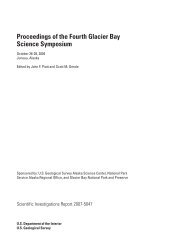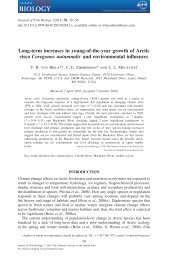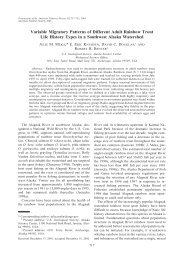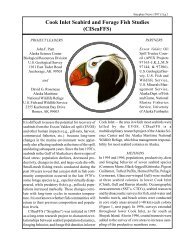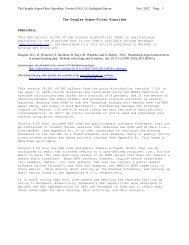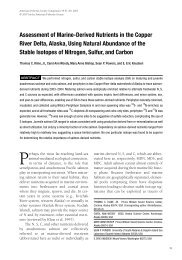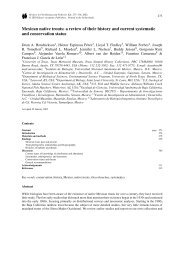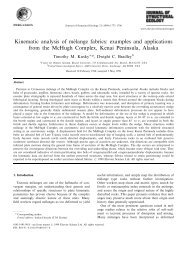Migration of Sakhalin taimen (Parahucho perryi) - Alaska Science ...
Migration of Sakhalin taimen (Parahucho perryi) - Alaska Science ...
Migration of Sakhalin taimen (Parahucho perryi) - Alaska Science ...
Create successful ePaper yourself
Turn your PDF publications into a flip-book with our unique Google optimized e-Paper software.
Environ Biol Fishthat were incidental to other fisheries or collectedfrom carcasses recovered in freshwater. In addition,sagittal otoliths were collected from a masu salmonand a white spotted char in the Koppi River. The masusalmon and white spotted char were presumed to havemigrated to sea (Arai and Tsukamoto 1998; AraiandMorita 2005) and were included for comparison withputative migratory fish. The otoliths from Koppi andTumnin River fishes were obtained through a jointresearch project involving the Wild Salmon Center andthe Khabarovsk TINRO during 2000–2002. Afterremoval, all otoliths were cleaned and stored in dryvials until analysis.Otolith preparation and analysisThe chemical composition <strong>of</strong> otoliths can be used todescribe migration in anadromous fishes based onexamination <strong>of</strong> the ratio <strong>of</strong> strontium (Sr) and calcium(Ca) (Kalish 1990; Secor 1992; Volk et al. 2000).Strontium, an element with binding characteristicssimilar to Ca, is substituted for Ca in the calciumcarbonate matrix <strong>of</strong> the otolith at levels relative to theconcentration <strong>of</strong> Sr in the environment (Kalish 1990;Zimmerman 2005; Arai 2010). Because Sr/Ca isgenerally greater (3 to 10 x) in seawater comparedto freshwater (Odum 1951) and the concentration <strong>of</strong>Sr is correlated with salinity (Odum 1951; Ingram andSloan 1992; Zimmerman 2005), analysis <strong>of</strong> Sr/Caratios across the otolith <strong>of</strong> a fish can identify growthoccurring in freshwater and saltwater.One sagittal otolith from each fish was embeddedin epoxy (Epo-Thin, Buehler Ltd.) and a transversesection was cut through the core using a diamondwafering saw. Otolith mounting and preparationfollowed the methods <strong>of</strong> Donohoe and Zimmerman(2010). The transverse section was glued to a coverslip attached to a glass slide on one edge and groundwith 2000-grit sandpaper to remove saw marks. Thesection was then polished with a slurry <strong>of</strong> 0.05 μmalumina paste. The cover slip was cut with a scribe sothat several prepared otoliths could be mounted on apetrographic slide for microprobe analysis. Thepetrographic slide containing several otoliths wasrinsed with deionized water, air dried, and carboncoated. Elemental analysis was conducted with aJEOL JXA-8800 L wavelength dispersive microprobe.A 15 kV, 50 nA, 10 μm-diameter beam wasused for all analyses (Zimmerman and Nielsen 2003).Strontiantite (SrCO 3 ) and calcite (CaCO 3 ) were usedas standards for Sr and Ca, respectively. Each elementwas analyzed simultaneously, and a counting time <strong>of</strong>40 s was used to maximize precision (Toole andNielsen 1992). Strontium was measured using theTAP crystal, and Ca was measured using the PETcrystal. A transect <strong>of</strong> points with a spacing <strong>of</strong> 10 to25 μm was measured from the center <strong>of</strong> the core tothe edge <strong>of</strong> the otolith. To quantify the variability <strong>of</strong>otolith Sr/Ca among samples, we calculated thecoefficient <strong>of</strong> variation (CV) as the SD Sr/Ca × meanSr/Ca −1 for each fish. We assumed fish that hadmigrated from freshwater to seawater would havehigher CV than fish that remained in freshwater.After microchemical analysis, the carbon layer wascleaned from the surface <strong>of</strong> otoliths and each otolithwas photographed at a magnification <strong>of</strong> 45x using adigital camera connected to a dissecting microscope.The otolith was placed on a black background andreflected light was used to accentuate the presumedannuli (Fig. 2). The age <strong>of</strong> each fish was determinedby counting alternating translucent and opaqueregions. Under reflected light, annuli correspond tothe translucent zone (Kalish et al. 1995). The distancefrom the center <strong>of</strong> the core to each annulus wasmeasured along a standardized transect. To describethe relation between age and migration, we plottedannuli over transects <strong>of</strong> otolith Sr/Ca.ResultsAges <strong>of</strong> <strong>taimen</strong> examined ranged from 3 to 20, andfork lengths at time <strong>of</strong> capture ranged from 36 to115 cm (Table 1). Otolith Sr/Ca across a transect <strong>of</strong>points beginning in the core and ending at the edge <strong>of</strong>the masu salmon otolith was similar to that <strong>of</strong>anadromous salmonids reported previously (e.g.,Kalish 1990; Arai and Tsukamoto 1998) with a regionFig. 2 Micrograph <strong>of</strong> a transverse section <strong>of</strong> a <strong>taimen</strong> otolith toillustrate annuli that are indicated by black squares




